
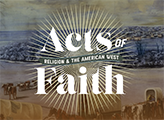




Latter-day Saints in Deseret
The first companies of
Latter-day Saints reached the Salt Lake Valley in 1847. They called their new
home Deseret, a name Brigham Young had plucked from the Book of Mormon.
Divine guidance and knowledgeable informants had led them
here. But how could they secure it for themselves? Ute, Paiute, Shoshone, and
Bannock peoples had long belonged to this land. The United States claimed it
too. By parrying demands from all sides—sometimes with diplomacy; other times
with violence—the community put down roots.
Although Congress rejected
the Saints' bid to make Deseret a state, their vision for a godly society lived
on in Utah Territory. President Millard Fillmore appointed Brigham Young as Utah’s
territorial governor in 1850. After the Saints announced their practice of
polygamy, or plural marriage, Young lost the governorship. But he did not lose
his influence with those who considered him a prophet.
The Saints continued to
defend their church-run society and their right to religious liberty despite US
government claims that their political and religious practices made them
unworthy of statehood.
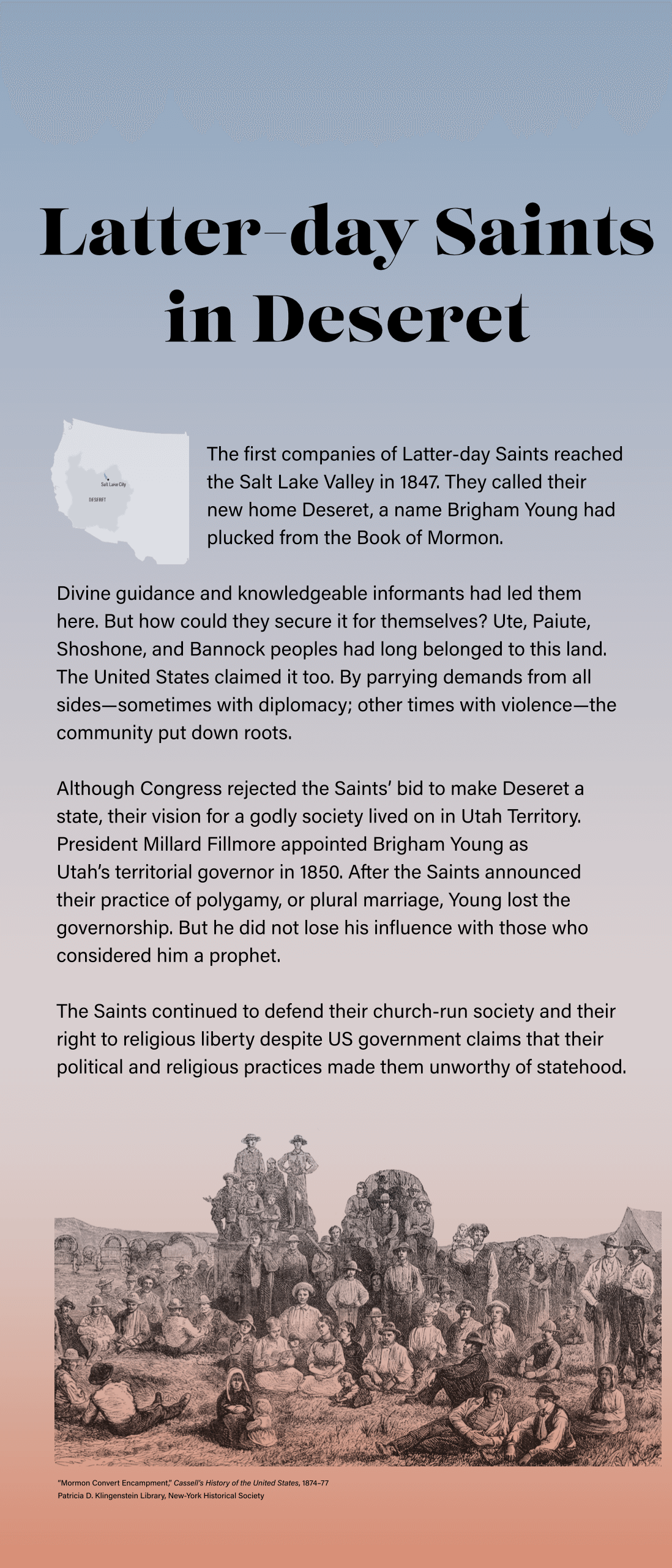
“Mormon
Convert Encampment,” Cassell’s History of
the United States, 1874–77
Patricia
D. Klingenstein Library, New-York Historical Society

Beehive, ca. 1870
Church History Museum
Deseret & Beehives
In the Book of Mormon, the
word Deseret signified honeybee. Although most Americans understood
hives of bees as symbols of cooperative labor, in Utah that symbolism acquired
a deeper meaning. In 1854, Brigham Young installed a symbolic beehive on the
cupola of his house. The Saints believed their cooperative efforts would
fulfill the prophecy of Isaiah that the desert would “blossom as the rose.”
Successfully negotiating
with, and converting, local Indigenous groups figured high among Young’s aims.
The Book of Mormon identified
Indians as Lamanites—descendants of ancient Israelites who traveled to the
Americas before the Biblical destruction of Jerusalem. Converting Native people
would do more than secure peace in Deseret. It would fulfill Book of Mormon
prophecies.
Wakara & Brigham Young
The world of the Timpanogos
Ute leader Wakara (ca. 1808–1855) reflected the legacy of cultural disruption,
disease, and violence that began with Spanish colonization of the Southwest
several centuries before. Wakara excelled at navigating this changed
environment, achieving success as a horse trader and raider along the route to
California.
Wakara recognized both threat
and opportunity in the Latter-day Saints’ colonization. He directed Brigham
Young to settlement sites that enhanced his Timpanogos Band’s position. And he
used his trading and raiding to maintain his community's stature while coping
with the transformation of land and economy wrought by the Mormons.
In 1850, Wakara and some of
his men agreed to Mormon baptism, and Wakara received ordination as an Elder.
This position may have helped him protect Ute land and sovereignty from Mormon
expansion. But soon, with settler violence increasing and Ute subsistence at
risk, Wakara led attacks against Mormon settlements. The resulting conflicts
ended with a shaky détente in 1854.

Brigham Young, ca. 1855
L. Tom Perry Special Collections, Harold B. Lee
Library, Brigham Young University
Converts & Emigrants
This trunk bears the name of a
Swiss family of converts whose members first immigrated to Utah in 1860. Such
trunks carried household goods and clothing, and might also serve as the
emigrants' first furniture once settled in their new home.
Gathering
converts from throughout the world was central to the cause of Zion. Once
baptized, the Church helped new members join their fellow Saints in Utah.
Between 1847 and the coming of the railroad, roughly 70,000 people followed the Mormon Trail to Salt Lake City.
Most traveled in Church-managed
wagon companies. Others pushed their own possessions in handcarts. A “Perpetual
Emigration Fund” supported those without resources, asking them to support
future migrants by paying back loans when they could.
Newcomers were folded into
the community through marriages and religious rituals. They also learned about
the community's trials and triumphs in church, where stories of persecution and
martyrdom were told and retold.
Wagon train crossing the Platte River, ca. 1840s–50s
Special Collections, J. Willard Marriott Library,
University of Utah
P0120 Philip T. Blair Photograph Collection

Emigrant trunk, ca. 1880
Courtesy of the Utah Historical Society
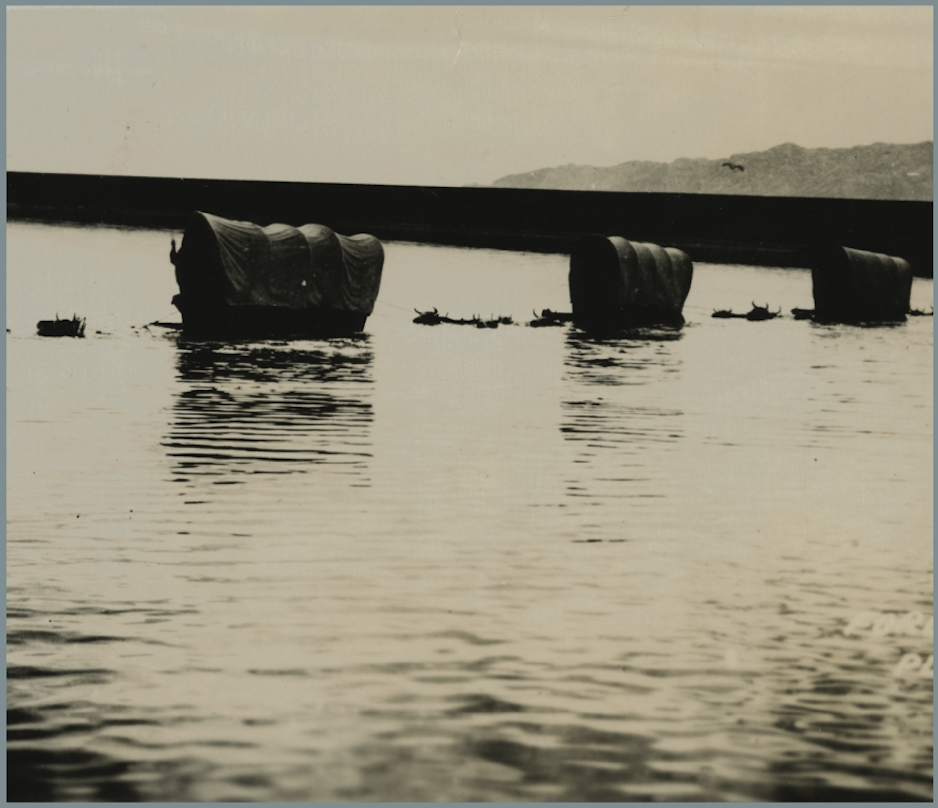
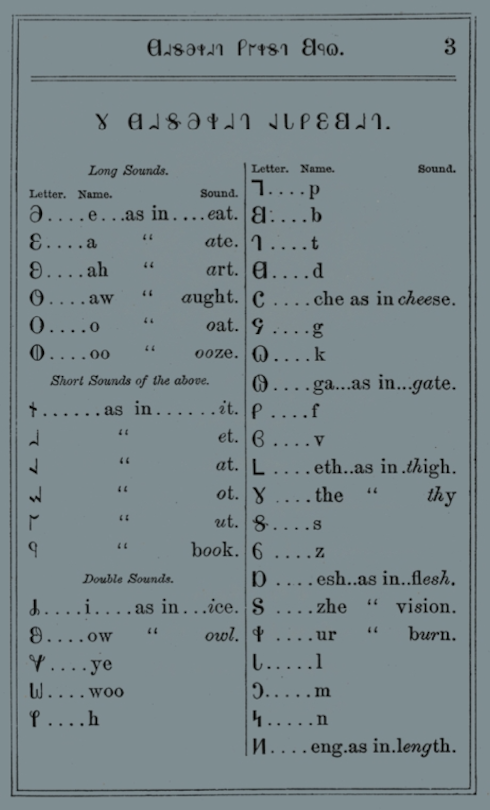
[The Deseret
First Book],
1868
Patricia D. Klingenstein Library, New-York
Historical Society
The Deseret Alphabet
Scholars at the newly
established University of Deseret (later Utah) attempted to aid non-English
speaking converts by offering a phonemic, or sound-based, spelling system
called the “Deseret Alphabet.” This instructional booklet was printed during
the alphabet's brief period of popularity.
The alphabet’s principal
inventor, a British convert, wrote admiringly of the Cherokee linguist Sequoyah
who invented an alphabet on the same principle decades earlier. (Sequoyah’s syllabary is featured in the next section, Cherokee Nation Reunited)
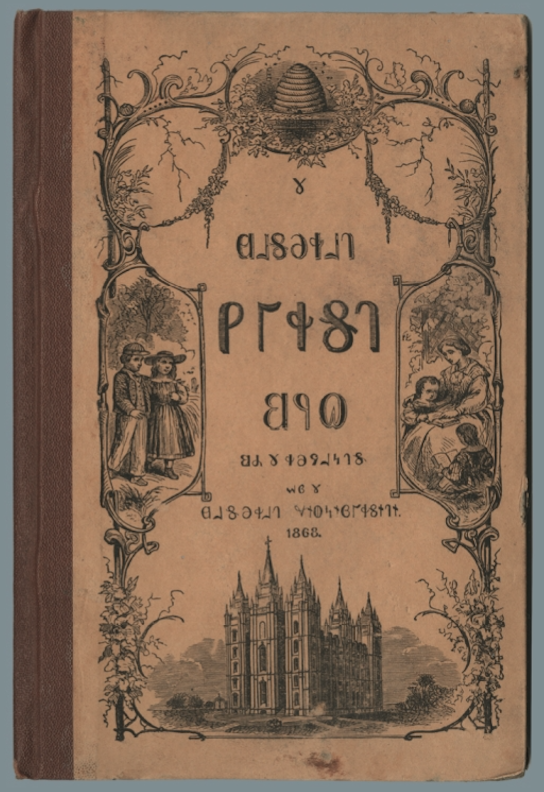

Tabernacle under construction, Salt Lake City
Patricia D. Klingenstein Library, New-York
Historical Society
The Community
Over 60 members of Salt Lake
City’s 14th Ward Female Relief Society created this giant quilt in 1857. It
demonstrates the Latter-day Saint embrace of collective labor and individual
creativity. Although the quilters shared fabrics, no two squares are exactly
alike. Most signed or stitched their names below their appliqued motifs.
These women had already
produced clothing for Paiute converts, woven rag carpets for the Tabernacle,
and integrated an endless stream of newcomers into the territory. Some among
them had been part of the first Female Relief Society in Nauvoo.
As Salt Lake City blossomed
into a kind of oasis for migrants on the overland trail to California, the
Saints established close to 100 new settlements to the south, some focused on
farming, some on iron or cotton production. These tiny communities formed a
300-mile chain down the center of the territory.
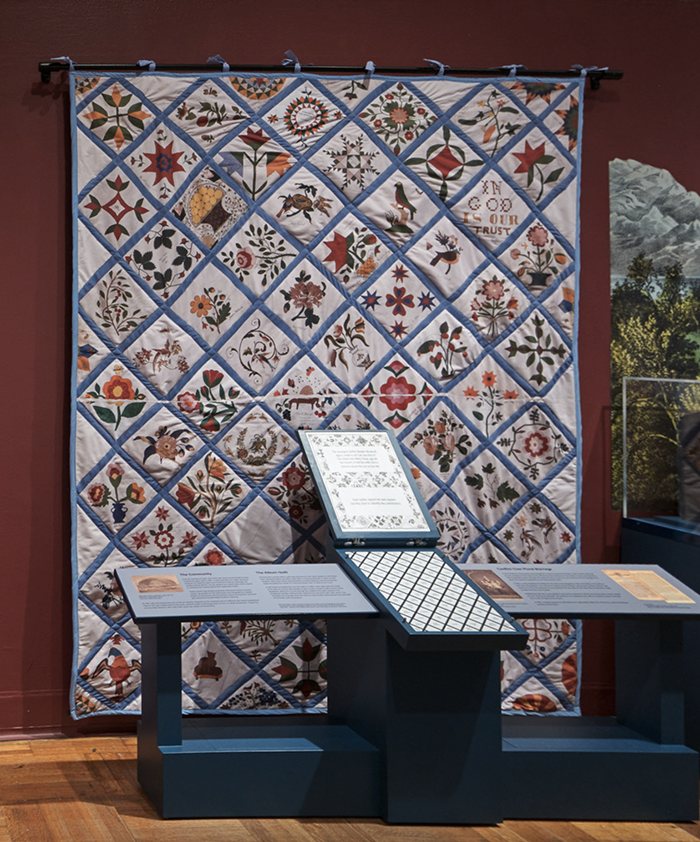
14th Ward Album Quilt. Facsimile. Images of the quilt and short biographies of its makers can be found in Carol Holindrake Nielson’s book, The Salt Lake City 14th Ward Album Quilt, 1857 - Stories of the Relief Society Women and Their Quilt, University of Utah Press
The Album Quilt
Choosing the popular album
quilt style allowed the 14th Ward quilters to showcase their individual talents
and affirm their faith in mottoes stitched or inked on their squares. Notice
the varied representations of bees, beehives, and the American eagle alongside
the words “In Unity We Stand” and “In God Is Our Trust.”
A 14th Ward schoolteacher won
the quilt in a raffle. Years later, after the death of his wife, he cut the
quilt exactly in half in order to
share it with his two eldest daughters. (Note the cut line through the middle
of the quilt squares.) The daughters’ families retained their portions but lost
touch with each other. That changed not long ago when the wife of a descendant
rediscovered and rekindled the families’ quilt connection.

Orson Pratt
“Celestial Marriage,” The Seer, January 1853
Patricia D. Klingenstein Library, New-York
Historical Society
Conflict Over Plural Marriage
In 1852, Brigham Young openly
acknowledged the practice of plural marriage in Utah Territory. Although he and
a handful of other high Church officials became infamous for the number of
wives and children in their households, plural marriage was never the only, or
even the most common form of marriage. At its peak, the majority of polygamous
men had only two wives.
In 1856, a newly established
Republican Party denounced polygamy in Utah and slavery in the South as “twin
relics of barbarism.” The next year, President James Buchanan sent troops to
assert control of Utah Territory. As US forces advanced, Young organized the
evacuation of Salt Lake City and warned he would not allow the city to be
occupied.
Negotiations followed. Young
agreed to step down as governor and the army promised to remain outside the
city. “Buchanan’s Blunder” did nothing to end polygamy, but it did turn support
for plural marriage into a mark of loyalty to the Church.
In 1862, Congress passed an
anti-bigamy act, fueling efforts after the Civil War to control the religious practices
of the Saints.